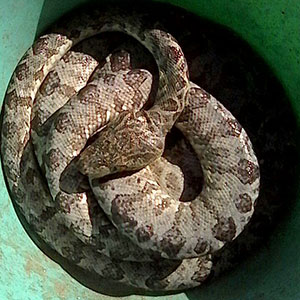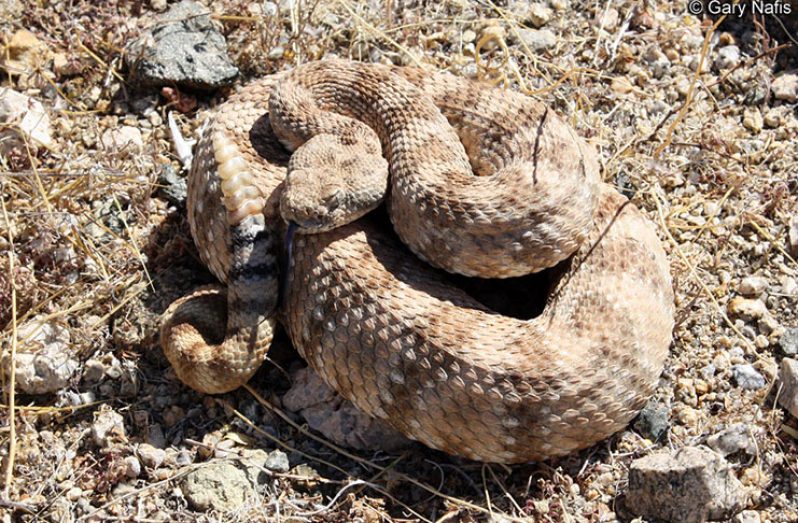– some of the most venomous in Guyana
By M Margaret Burke
GUYANA, as part of the South American continent, is swamped with rainforests and jungles, which has the type of terrain where snakes and other wildlife creatures thrive. And it has been reported over time that this continent has some of the most dangerous, as well as some of the most enthralling snakes in the world.
Venomous snakes and dry bites
Wildlife handler and exporter, Mr Kurt Herzog, in an invited discussion on venomous snakes found in Guyana, listed eight such snakes: the Brown labaria, Green labaria, Rattle snake, Bushmaster, Morabana, Coral snake, Parrot snake and the Water cobra.
He said that of all these snakes, the rattle snake can be found mostly in savannah areas, while the others can be found in forested areas; sometimes in other areas, which may even be considered residential, as well as in swampy areas or even in water.
Herzog said that even though these snakes are venomous and in most cases if the bite is not treated in a timely manner can result in death, yet none of them would just attack people.
“I don’t know of any snake attacking people, all snakes run away – they all run away, even the bushmaster.
“But the problem is that if you are walking in the bush and a snake is hiding somewhere and you walk into its path and mash it, it will bite you right away, but it would not really do you anything much, even though it is a venomous snake, because it did not expect you and so it did not get a chance to really work up its poison.
“So, let’s say that a man is working in an area and he is knocking on a piece of zinc sheet, which has a labaria snake underneath, he is alerting the snake all the time, so by the time he raise up that zinc sheet, if he get a bite, I am sure it is a wet bite and that can be serious, it can be fatal.”

The coral snake
Herzog, in dealing with the most venomous snakes, said, “The coral snake can be found in water, as well as on land. Sometimes when going on the highway you see them crawling across the road. It can even be found in swampy places, possibly in yards, be stressed.
Coral snake – Micrurus
“Once it is the red, white and black coral it is the real thing. There are plenty different coral snakes in Guyana, but this is the most common one and it is venomous,” Herzog said.
He said that coral snakes do not look for people to bite them, instead, they try to avoid them. For their meals they feed on frogs (which can be poisonous), lizards, birds, fish and even other snakes that are most times smaller.

The labaria (brown and green)
“These are very nervous snakes; once they feel threatened, they would bite you fast, fast, fast; before you even realise it they could bite you five times already. They are very hot-tempered and most people that get bite, get bite by that same snake-type.
Brown labaria-Bothriopsis bilineata Green labaria – Bothrops atrox
“All of them [venomous snakes], I guess is the same thing, but when compared to a labaria, which strikes very fast, the bushmaster’s strike is much slower. And as I said before, the labaria’s bite is very deadly,” Herzog said.

The bushmaster
“The Bushmaster has a lot of venom inside of it, but you may still be able to get away from it because he is not that fast. And, its venom is not that strong – and many times its bite is a dry bite, even though it can and does inflict deadly venom on people at times.” He explained that this venomous pit viper can grow more than three, four metres and possibly more. It is a very heavy-built snake, sort of hefty looking serpent, but can be easily subdued once people understand how to handle and manage them.

The rattle snake
“The rattle snake has terribly strong venom. He is far, far more deadly than a labaria or a bushmaster. While it is found in the savannah mostly, or even in the backdam areas, they may also be found in yards, but people kill them out once they find them in their yards.
Rattle snake – Crotalus durissus
“They kill all the snakes, as a matter of fact. When people see a snake, they say only a dead snake is a good snake, so they kill them all the time,” he said.

Morabana (Bothrops brazili), also described as Brazil’s Lancehead
The Morabana – Bothrops brazili is a venomous pitviper specie, which appears to be deep pink or red with some amount of grey in colour; is usually heavy-set and primarily found on the earth, though it can be found in water (passing through). It is a big snake and can be as long as five to six feet, or even more. According to Herzog, the females are usually larger than the males.

Water cobra (Guyana)
This Water Cobra or hydrodynastes gigas is usually referred to as the false water cobra and the wildlife exporter, Mr Kurt Herzog, told the Guyana Chronicle that he has handled this snake right here in Guyana. He said that his catch has been disputed by some of his colleagues as not being found here, but he insisted that this serpent can be found here in Guyana.
The Parrot snake – Bothriopsis bilineata
The snake of many names, the parrot snake (Bothriopsis bilineata) or (Leptophis ahaetulla), with common names such as: two-striped forest-pitviper and Amazonian palm viper is not a very large snake. This snake can be seen in three distinct colours, a bronze-like colour, green and gold, with white or yellow upper lips.
The bite of the parrot snake can cause some problems, such as pains, swelling and a constant sticking-like feeling. “Like the venom of other snakes, if not treated properly, can cause serious problems also,” Herzog said.

Not the hospital but the priest
Herzog said that while one type of anti-venom can be used for most the venomous snakes listed above, it is not the same for the coral snake.
“If the coral snake bites you, you don’t go by the hospital; you go by the priest, because if he gets you, if he really gets you, they don’t have anything here to save you; that thing destroys your blood and your nervous system.
“But it hardly ever bite people, it is very, very difficult for that snake to bite you because it don’t have front teeth in the mouth, all the fangs till at the back; if the coral snake bite you, it has to go sideways and chew at you, he can’t get you straight like that to bite you – it is very difficult,” Herzog offered. (mercilinburke2017@gmail.com)



.jpg)











